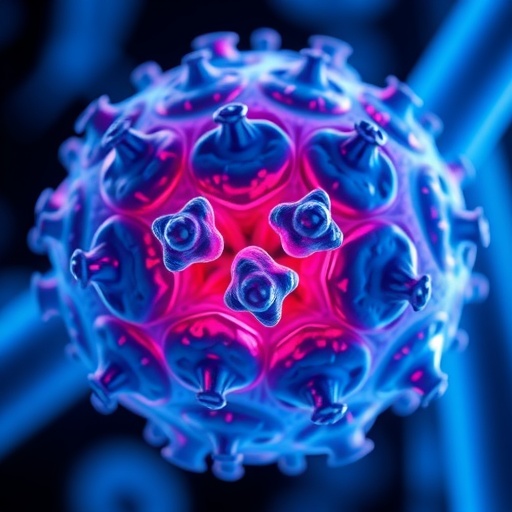Researchers at the Francis Crick Institute in collaboration with Vividion Therapeutics have unveiled a groundbreaking approach to halting cancer progression by selectively disrupting the interaction between the oncogenic protein RAS and the crucial signalling enzyme PI3K. This novel strategy targets a molecular handshake that fuels tumor growth without interfering with essential physiological functions, potentially ushering in a new era of cancer therapies that maximize efficacy while minimizing side effects. The findings have been published in the journal Science and the investigational compounds are now advancing into first-in-human clinical trials.
RAS is one of the most frequently mutated genes in human cancers, present in about 20 percent of all cases. Its protein product acts as a master regulator of cell proliferation by initiating multiple downstream signalling cascades. Oncogenic mutations lock RAS protein in an active, GTP-bound state, relentlessly promoting cell division and tumorigenesis. Despite being a key cancer driver, directly targeting RAS has long eluded drug developers due to its high affinity for GTP/GDP and the smooth surfaces devoid of good binding pockets.
Instead, the research teams focused on a critical effector of RAS: the phosphoinositide 3-kinase enzyme PI3K, which propagates signals essential for cell growth and survival. However, indiscriminate inhibition of PI3K has posed significant clinical challenges because this enzyme also participates in vital functions like insulin signalling. Inhibitors that block PI3K broadly often incur metabolic toxicities such as hyperglycemia, limiting their therapeutic window.
To solve this conundrum, scientists employed a combination of sophisticated chemical biology methods and selective compound screening to identify molecules capable of covalently binding near the RAS-binding domain of PI3Kα isoform. These small molecules irreversibly attach to specific amino acid residues at the PI3K surface, effectively occluding the RAS binding site. Remarkably, this selectivity preserves PI3K’s ability to engage with other interaction partners, such as those in the insulin signalling axis, thereby reducing systemic side effects.
A bespoke biochemical assay developed at the Crick Institute enabled the verification that these covalent inhibitors disrupted the PI3K-RAS interaction with high specificity. Structural and functional characterizations confirmed that the compounds prevent the pathogenic activation loop driven by mutant RAS without compromising normal enzyme activity necessary for homeostasis. This targeted mechanism represents a major leap forward in precision oncology.
The in vivo efficacy of one leading compound was judiciously evaluated in mouse models engineered to develop RAS-mutated lung tumors. Treatment led to significant arrest of tumor progression without detectable increases in blood glucose levels. This outcome underscores the concept that uncoupling RAS-dependent oncogenic signalling from PI3K can suppress tumors effectively while sparing healthy physiology, a milestone in mitigating the therapy-limiting toxicities observed with previous PI3K inhibitors.
Further investigations demonstrated that combining the PI3K-RAS interaction blocker with other drugs targeting parallel nodes within the RAS pathway resulted in synergistic and durable tumor control. The combination therapies enhanced suppression of tumor growth beyond the capability of single agents, providing a compelling rationale for multi-modal treatment regimens leveraging pathway redundancies to overcome cancer resistance mechanisms.
The scope of the drug’s utility expanded unexpectedly when researchers explored its effects against HER2-driven tumors, commonly found in breast cancer and characterized by overexpression of the HER2 receptor tyrosine kinase. Since HER2 also signals via PI3K, but operates independently of RAS, the inhibitor nonetheless blocked PI3K-driven tumor growth in these models. This intriguing discovery implies the drugs could serve as versatile therapeutics across a wider spectrum of cancers harboring mutations in either RAS or HER2 oncogenes.
Following these promising preclinical results, the lead compound has entered Phase 1 clinical trials designed to assess safety, tolerability, and preliminary efficacy in patients with tumors driven by RAS or HER2 mutations. The trial will also investigate whether administering the drug in combination with other agents targeting RAS-associated pathways enhances therapeutic outcomes. The initiation of this clinical evaluation represents a significant translational achievement stemming from deep mechanistic insights into protein-protein interactions and covalent drug design.
Julian Downward, Principal Group Leader at the Francis Crick Institute, highlighted the perseverance required to address one of oncology’s most challenging targets: “Our journey to disrupt RAS-driven signalling without harmful side effects reflects decades of fundamental biology research and innovative chemistry. The ability to selectively prevent RAS from binding PI3K while preserving other cellular functions exemplifies how nuanced targeting can unlock new treatment avenues.”
Matt Patricelli, Chief Scientific Officer at Vividion Therapeutics, emphasized the transformative potential of this discovery for drug development: “These covalent inhibitors open a fresh paradigm for targeting oncogenic signalling complexes. By precisely blocking pathological protein interactions rather than entire enzymes, we have created molecules that can thwart tumor growth while maintaining normal cellular processes. Seeing this science advance into the clinic is truly rewarding.”
This breakthrough exemplifies the power of combining chemical biology, structural insights, and rigorous preclinical validation to overcome long-standing barriers in drug discovery. Should clinical trials validate safety and efficacy in humans, these compounds offer hope for improved therapies that can more effectively combat cancers driven by RAS and HER2 mutations without the burden of debilitating side effects. The approach also lays the groundwork for the design of next-generation molecular glues and inhibitors that selectively modulate oncogenic signalling pathways with unprecedented precision.
The Francis Crick Institute continues its mission to translate fundamental scientific insights into impactful medical advances that can save and improve lives. This collaboration with Vividion Therapeutics underscores the synergy between academic research and industry innovation, fostering rapid development of targeted cancer therapies. As this drug candidate progresses through clinical evaluation, it positions itself at the forefront of precision oncology focused on exploiting vulnerabilities in cancer cell signalling networks.
Subject of Research: Targeted disruption of the RAS-PI3K interaction to inhibit tumor growth in cancers driven by RAS and HER2 mutations.
Article Title: Covalent inhibitors of the PI3Kα RAS binding domain impair tumor growth driven by RAS and HER2
News Publication Date: 9 October 2025
Web References: http://dx.doi.org/10.1126/science.adv2684
References: Klebba, J. et al. (2025). Covalent inhibitors of the PI3Kα RAS binding domain impair tumor growth driven by RAS and HER2. Science. 10.1126/science.adv2684.
Keywords: Drug discovery, Tumor cells




